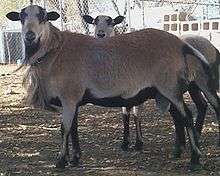Barbados Black Belly
The Barbados Black Belly is a breed of domestic sheep from the Caribbean island of Barbados. Although it is likely the Barbados Blackbelly has African ancestry, there seems to be clear evidence that the breed, as seen today, was developed by the people on the island from sheep brought by ships fairly early in the period after Europeans first arrived.[2] This breed is raised primarily for meat.[3] It is widely distributed, with populations in twenty-five countries in the Americas, Asia and Europe. It is most abundant in the Caribbean region, in Mexico and in Peru.[1] In 2015 the total world population was estimated at about 158,000.[1] In 2014, the US reported 1,971 registered sheep. [4]
 Barbados Black Belly ram | |
| Other names |
|
|---|---|
| Country of origin | Barbados |
| Distribution | 25 countries world-wide, mainly Caribbean and South America[1] |
| Use | Meat |
| Face colour | Black, brown |
| Notes | |
| Able to tolerate heat | |
| |
History in the US
In 1904, the USDA imported a small flock and transported them for study to Bethesda, Maryland. From that original flock, at least two distinct breeds have emerged in the US, and there is a great deal of confusion in the breed names. In 2004, there were fewer than 200 purebred Barbados Blackbelly sheep in the US, in contrast to a large and growing population of a popular crossbreed, commonly referred to as "Barbado." Whereas purebred Barbados Blackbelly rams and ewes are polled (hornless), the Barbado is most noted for the regal rack of horns on the rams, and some ewes may also have small horns. The horns were gained by crossbreeding Barbados Blackbelly with Mouflon and Rambouillet early after they were imported by the USDA. The rams with large horn curl are commercially bred for use on private hunting ranches where size of horn curl is prized by exotic game hunters.
Renaming
Recognizing that the term "Barbado" did not adequately define the characteristics that breeders sought in the horned animal, the Barbados Blackbelly Sheep Association International (BBSAI) adopted a breed standard in 2004 and defined animals meeting this standard as "American Blackbelly." As a result, breeders of both breeds of sheep were better able to obtain genetics of their breed of choice with some certainty that the animals would breed to type. In 2014, there were more than 1,900 registered Barbados Blackbelly sheep in the US, and although the breed is not out of danger, it is far more stable than it has ever been in the US
Characteristics
Blackbelly sheep of both breeds are able to tolerate heat and exhibit more stamina than most breeds of sheep. They are fleet of foot and in many ways resembles deer. They are "hair sheep," which means they don't grow wool, but instead they have coarse hair. If raised in cooler climates, they often develop a wool undercoat that they shed in the spring.
Barbados Blackbelly sheep will breed all year round unlike most domestic sheep. Because they are smaller and slower growing than most wooled sheep, they are not a good choice for commercial production. However, there is a strong market for their lean and mild-flavoured meat, and they are popular with herding dog trainers. They are very disease resistant and parasite tolerant, and these genetic traits have created a demand for Blackbelly sheep in crossbreeding operations. These sheep can be raised with very little grain, and do not require intensive management. Blackbelly sheep range in colour from light tan to a dark mahogany red, with black stripes on the face and black legs, belly, inguinal region, chin, and chest, which gives this herbivore its name. Despite being goat-like in appearance, they are true sheep.
Registries
There are two breed associations in North America for Blackbelly sheep.
- The Barbados Blackbelly Sheep Association International (BBSAI) welcomes both Barbados Blackbelly and American Blackbelly and has a herd-book for each. Both are closed, meaning that only sheep whose parents are registered can be registered themselves. There are over 3,500 sheep registered with the BBSAI.
- The North American Barbados Blackbelly Sheep Registry primarily registers the horned Blackbelly sheep.
Crossbred and purebred sheep in Europe
In the 20th century, many Barbados sheep were brought from Barbados to the UK and mainland Europe, where it gained popularity. Due to the lack of mutual knowledge among hobbyists and sheep farmers, sometimes Barbados sheep are confused with Djallonké (Cameroon sheep). As a result, there are many crosses of these two breeds in Europe. Some breeders mistakenly offer crossed and pure Barbados sheep as being Djallonké (Cameroon sheep or West African dwarf sheep).[5]
References
- Transboundary breed: Barbados Black Belly. Domestic Animal Diversity Information System of the Food and Agriculture Organization of the United Nations. Accessed September 2015.
- "Barbados Blackbelly". Breeds of Sheep. Oklahoma State University. Archived from the original on 25 February 2009. Retrieved 20 March 2009.
- "Barbados Black Belly/Grenada". Breed Data Sheet. Domestic Animal Diversity Information System. Retrieved 11 September 2009.
- . Domestic Animal Diversity Information System of the Food and Agriculture Organization of the United Nations. Accessed September 2015.
- https://www.ornamental-breeders.org/djallonk%C3%A9-sheep-breed-standard
External links
- http://blackbellysheep.org The Barbados Blackbelly Sheep Association International (BBSAI)
- http://barbados.sheepregistry.com The North American Barbados Blackbelly Sheep Registry
- https://web.archive.org/web/20181220165704/http://www.blackbellysheep.info/ An email group for Barbados Blackbelly, American Blackbelly, and Barbado sheep breeders
- http://www.fao.org/DOCREP/004/X6517E/X6517E02.htm#ch2.1 Comprehensive FAO Book Chapter on Barbados Blackbelly Sheep
- http://www.barbadosblackbelly.com Barbados Blackbelly Hair Sheep - the most complete source of information about the breed available on the Internet
- http://sites.google.com/site/blackbellysheepbook/ The Blackbelly Sheep Book - A Wiki-based book for people who raise either Barbados Blackbelly or American Blackbelly sheep